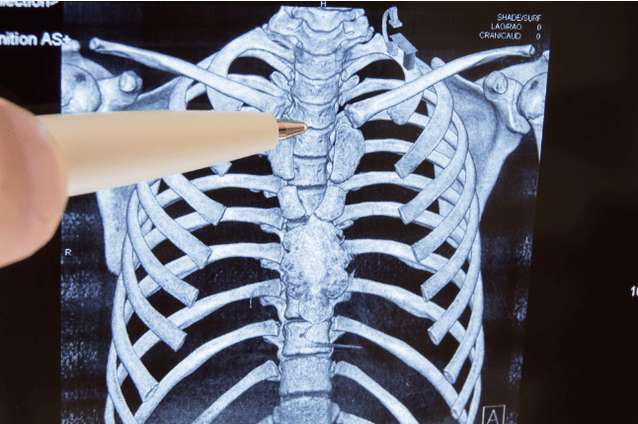Osteochondrosis is a spine disease in which interverters (and subsequent body of vertebrae, joints and ligaments) lose their ability to function normal.

The cause of osteochondrose is currently considered a set of factors that affect the spine during the person's life.Additional risk of osteochondrose develops the resulting brackets of the spinal column, as well as holding disorder.Some patients recorded a connection to the occurrence of disease and hypothermia.
In practice it is common to consider
- cervical osteochondrosis,
- Osteochondrosis of thoracic and
- Lumbar spine.
Separately, it should be noted that osteochondrosis is common, characterized by damage to several parts of the spine at once.
The most common are uterine and thoracic forms, as these spine departments are subject to the greatest loads.
Symptoms of osteochondrose
With osteochondrose, patients describe symptoms such as:
- Paroxysmal or shooting in spine affected by osteochondrose;
- increased pain after physical effort, as in the morning;
- Pain can be given on neck, arm or leg, as well as in chest;
- The feeling of crumbs when performing twisting.
Osteochondrose is also characterized by symptoms of neurological nature on the affected side:
- Partial violations of movement (paresis);
- An unpleasant sensation in the form of goosebumps, terre (paresthesia);
- The palpation is determined by the tension of the muscles corresponding to the affected department.
The disease begins and develops gradually rather than suddenly.
It is necessary to distinguish the osteochondrose of the spine from coronary heart disease (with coronary heart disease, the phenomenon of pain is not associated with physical activity, but is due to side factors: cough, extended seat).
Treatment
The same symptoms can be signs of various diseases, and the disease cannot occur in accordance with the textbook.Don't try to treat you - Consult your doctor.
Osteochondrosis therapy always requires an integrated approach.In treatment, the doctor's attention is needed like a therapist, rheumatologist, neuropathologist and physiotherapist.The treatment of osteochondrose of the spine depends on the localization, overcoming symptoms and severity of the disease.
Conservative therapy is aimed at removing the symptoms of pain, as well as the restoration of the normal spine function.
Rational nutrition for osteochondrose greatly facilitates the patient's condition and promotes more efficient therapy.Read more about the principles of osteochondrose nutrition in our separate article.
About 10% of patients are sent to surgical treatment.Absolute indicator for surgical intervention in osteochondrosis appearance of neurological disorders for pushing the spinal cord itself.
Additional indicators for surgical treatment of osteochondrose are considered the following:
- Extended periodic pain attacks;
- increased mobility and suspected instability in spine;
- Inefficiency of drug therapy 3 months;
- The disturbances that prevent the patient from leading lives.
Methods of surgical treatment
Surgical interventions with minimum traemation:
- Preparations - enzyme preparations are applied to an intervertebral disk after cracking with the aim of core and fibrous disc ring.
- Punch nucleotomy - intervertebral disk testing for removing parts of the poison.
- Denfal Denervation - The drug is introduced into an intervertal disk that blocks the sensitivity of nerve endings.
The remaining methods of surgical treatment of osteochondrose spine are less tender.They include:
- Completely or partial removal of an intervertebral disk or her hernia - This operation is focused on reducing compression symptoms.
- Prosthetics of intervertebral discs - The main task is to repair affected segments of the vertebral.
Operational methods for the treatment of osteochondrose spine provide forecast for full recovery in only 50% of cases.
With timely treatment, the life forecast is almost always favorable, but the forecast for working capability can be different due to a number of factors.
Osteochondrose exercises
Exercise 1.
Tilt your head forward, while pressing the forehead with woven fingers.Click your fingers in charge on the back of your head and whiskey - left, okay.The head opposes the hand pressure, and your hands - head pressure.Spend 10 seconds.for each movement.
Exercise 2.
Tips four fingers on the forehead on the forehead towards each other, press lightly on the skin by the entire surface of the palm and soft traction movements raster for 10-40 seconds.We can do the same stretching in the temple in the longitudinal and transverse direction.The same - in the ear - to stretch in all directions, especially in the loins.That.Improve blood circulation in areas of rich biologically active points.
Exercise 3.
This type of massage improves blood flow in the jugular veins, and the brain nutrition is improving.Sit exactly, the back is straight.Slowly pull your head back, helping in your hand, pressing the chin back and up.You can slowly turn your head a little left and right.Stay in this position for about a minute.For children is enough for 10 seconds.
Exercise 4.
This exercise improves the functioning of cervical nervous plexus.Sit exactly, the back is straight.Slowly tilt your head forward, trying to touch your chest chin.Put woven fingers on the back of your head, press forward and up, raising the back of your head.He sits so about a minute.You can repeat after 15 minutes.
Exercise 5.
Raise your shoulders up, trying to get it on your ears, lower, free, faster - 15 seconds.Now alternating - one shoulder up, the other is down, also 15 seconds.Pull the cervix with your palms.






















